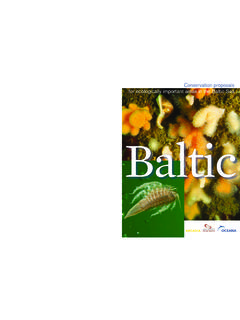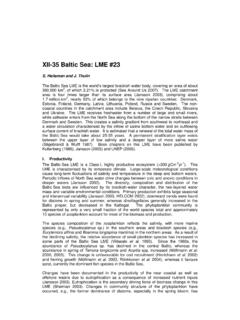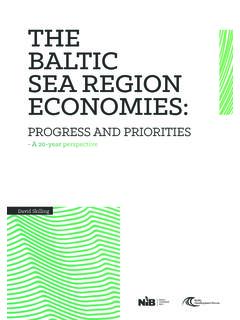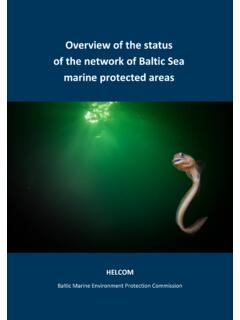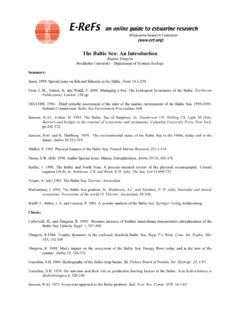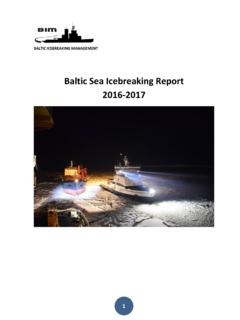Transcription of Assessment of sediment quality in Baltic Sea coastal waters
1 Assessment of sediment quality in Baltic Sea coastal waters Albrecht Mueller Abstract The investigations on the quality status of the sediments in the German Baltic Sea coastal waters focused on the natural background as Assessment basis. On this basis, the chemical sediment quality can be evaluated. Furthermore, the decision about the relocation of dredged material from federal waterways depends on this Assessment . The sediment quality of the German Baltic Sea coastal waters between the Kiel Bay and the Stettin Lagoon has been analyzed in order to obtain guide concentrations of the natural level. Relevant parameters had been selected according to the Helcom Liste of priority harmful substances metals (Hg, Cd, Cr, Cu, Pb, Ni, Zn and As), PAHs, MHC, PCBs and nutrients.
2 The results show that regional differences exist, so that a regionally differentiated Assessment is required. With regard to the removal of dredged material, a hierarchical decision support system for the re-use of that material was developed, including the disposal on land and in water. Ecological and economic conditions have to be compared in this decision making process. This procedure is illustrated at the example of the enlargement of the harbour access in the Wismar Bay. 1 Baltic Sea coastal waters Study area The Baltic coast has manifold features, including boddens (land-locked coastal waters ) and haffs. The bottom of the coastal waters of the Baltic Sea is characterized by Holocene deposits, especially late glacial marly till, which, in the deposition zones, is covered with recent, terrigenous silt.
3 Compared with the North Sea, the Baltic Sea has less interaction with the Atlantic Ocean, lower salinity, heavily reduced tidal effects, and a higher eutrophication potential. As a result, differentiated ecosystems have emerged along the Baltic coast (M ller and Heininger 1999). Anthropogenic impacts at the German coast are caused by the shipyard and seaport cities of Kiel, L beck, Wismar, Rostock, Stralsund, Wolgast, and Szczecin also by agriculture, which is a major sector of the economies in Schleswig-Holstein and Mecklenburg-Western Pomerania. The conditions of the rivers Trave, Peene, and Oder, for instance, reflect the industrial and agricultural activities in their catchment areas.
4 The quantification of the input of harmful substances into the Baltic Sea requires the consideration of the complex hydrological conditions of some of the estuaries (HELCOM 1993). In terms of quality , however, the anthropogenic impacts can be shown by the condition of the sediments in the coastal areas selected for examination: Kieler Bucht, L becker Bucht, Wismar Bay, Warnow Estuary, Darss-Zingst Chain of Boddens, R gen Boddens, Strelasund, Greifswald Bodden, Peenestrom and Stettin Lagoon. The contaminant parameters were select from the lists of priority substances which are covered by special provisions of the Helsinki Convention (HELCOM 1993). Heavy metals (Hg, Cd, Cu, Cr, Ni, Pb, Zn) and arsenic (As) are given as concentrations in the fine particle-size fraction of less than 20 m.
5 The organic contaminats include mineral oil hydrocarbons (MHCs), polycyclic aromatic hydrocarbons (PAHs), chlorinated pesticides (HCHs, DDTs), hexachlorbenzene (HCB), and polychlorinated biphenyls (PCBs). PAHs, chlorinated pesticides, and PCBs are discussed in terms of their total amounts represented by the sums of 16 individual PAH-compounds according to EPA 610, of - and -HCH, of o,p- and p,p-DDT and its DDD and DDE metabolites, and of the PCB-congeners 28, 52, 101, 138, 153, 180, respectively. The results for organic contaminants refer to the whole sample (<2 mm). _____German Federal Institute of Hydrology (BfG); Schnellerstrasse 140, 12439 Berlin; Structural Properties In the study areas, the percentage of silt (< 63 m) varies between 20 and 65.
6 In terms of mean values, the sediments in the Strelasund and in the Greifswald Bodden have the highest percentage of silt. The sediments in the Darss Chain of Boddens, in the R gen Boddens, in the Peenestrom, and in the Stettin Lagoon have a mean silt content of 60 %. The sediments in the Wismar Bay and in the outer region of the Warnow Estuary contained the lowest percentage of silt of only 10 %, respectively. The mean TOC varies between minimum mg/g in the Warnow Estuary and maximum 70 mg/g in the Peenestrom. Nutrients If the examined coastal areas were classified by their nutrient status, the outer Warnow Estuary, the R gen Boddens, the Wismar Bay, the Darss Chain of Boddens, and the Strelasund would rank in one group of comparable nutrient concentrations.
7 Compared with these coastal sections, the Stettin Lagoon and the Peenestrom have exceptionally high concentrations of nutrients. Heavy metals For a comparative consideration of the pollution with heavy metals, the mean concentrations in the fine particle-size fraction (< 20 m) were used. Obviously, the examined coastal areas can be divided into three groups; first, the Wismar Bay, the Darss Chain of Boddens, the outer estuary of the Warnow, and the Peenestrom; second, the R gen Boddens, the Strelasund and the Greifswald Bodden; and third, the Stettin Lagoon, which because of its significantly higher concentrations has a outstanding position. The heavy metal concentrations, especially as far as Hg, Cd, Cu, Pb, and Zn are concerned, tend to be lower in the western coastal sections and higher in the eastern ones.
8 Organic contaminants The total content of PAHs is less than 1 mg/kg in most of the coastal areas. The total range is to mg/kg. Clearly higher concentrations were found in the eastern areas Strelasund, Peenestrom, and Stettin Lagoon. A comparative statement can also be made for the content of MHC. Here the range of variation is 10 - 120 mg/kg, while the highest concentrations appear again in the three areas mentioned above. Low concentrations for PCBs, DDTs and HCHs, were found. In the case of HCB, the mean concentrations are also low. The data suggest that with respect to organic contaminants there is one group with comparable low pollution (outer estuary of the Warnow, Wismar Bay, Greifswald Bodden; R gen Boddens, and Darss Chain of Boddens) and another group with higher pollution (Strelasund, Peenestrom, and Stettin Lagoon).
9 2 Enlargement of the Harbour Access in the Wismar Bay The access channel to the harbour Wismar had to be widened from 60 to 120 m at a depth of 9 and 6 m respectively over a length of 6 km. In total, a volume of approximately 600 000 m3 material had to be dredged (M ller and N thel 2001). The investigation of the material showed that at the surface there is a layer moderately polluted by heavy metals Hg, Cu, Cd, Zn, and MHC, PCBs and PAHs. Additionally, mobilization of nutrients was observed. The decision about the disposal of the material on land or in the sea was related to the background concentrations of the Wismar Bay. In order to prevent further inputs of pollutants and additional eutrophication in the coastal waters , disposal on land of the moderately polluted material, in total 80 000 m3, was decided.
10 For the predominantly sandy material disposal in the sea, which is also the most cost effective approach, was accepted. The aim of this study was to ensure the ecological disposal of the material, to protect the aquatic organisms, the fishery and recreation in the Wismar Bay during dredging and disposal. Treatment Investigation and decision Assessment basis of dredged material Representative Assessment of status Natural background sampling according to morphological, chemical, biological, ecotoxicological studies Disposal Y principle of no-deterioration Dredged material concepts in sea observed?
